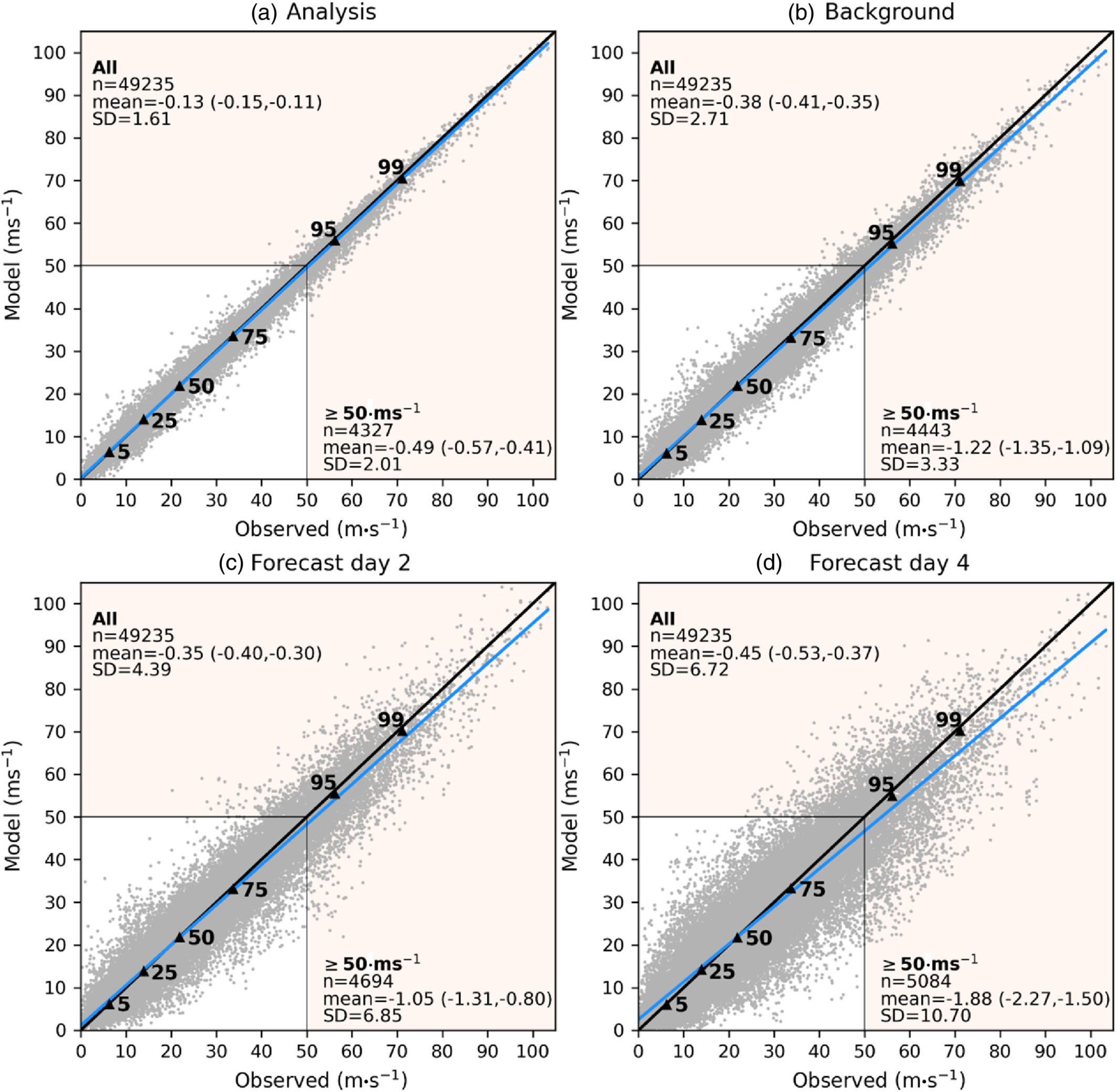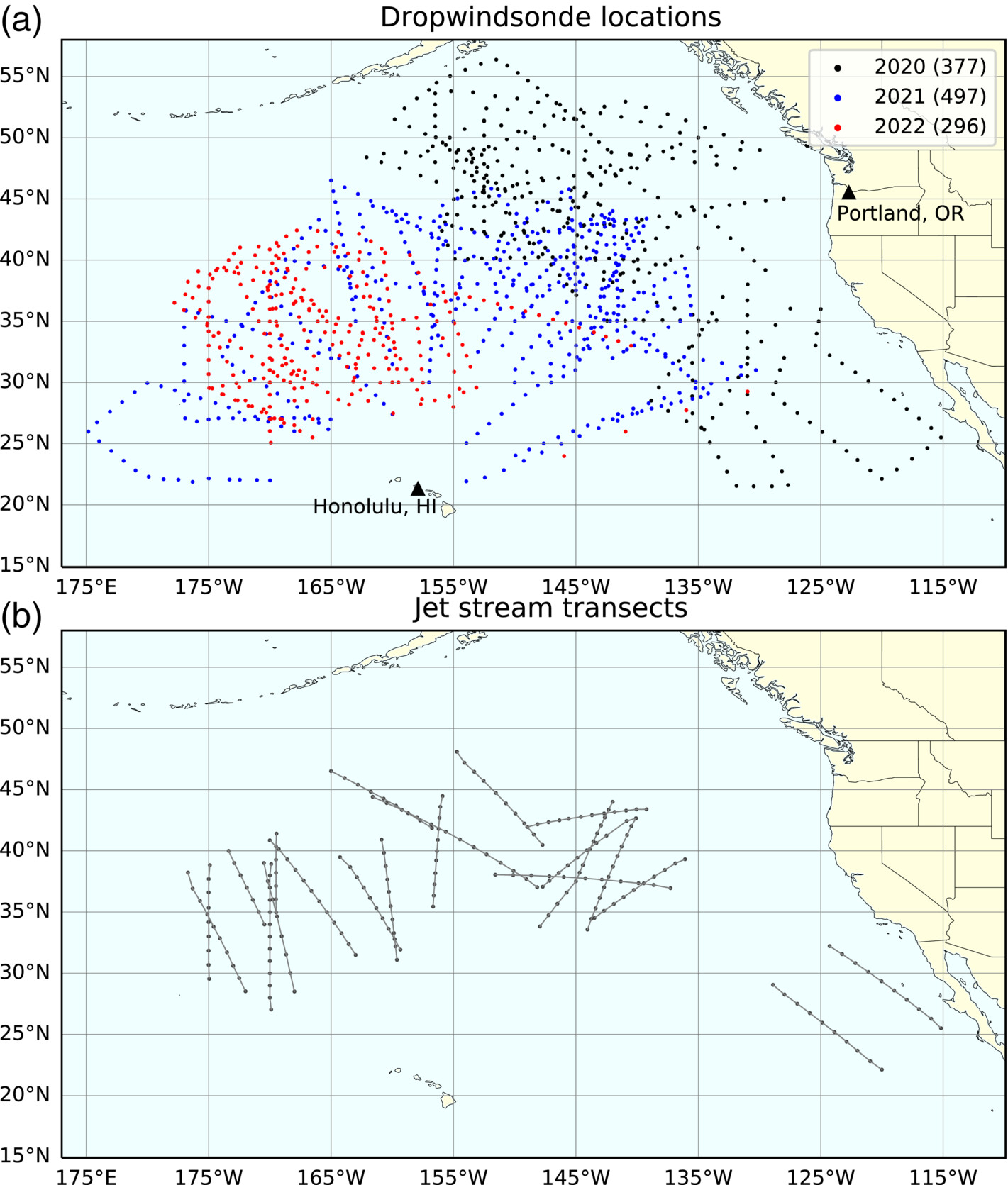CW3E Publication Notice
Forecast Evaluation of the North Pacific Jet Stream Using AR Recon Dropwindsondes
August 9, 2023
A new paper titled Forecast Evaluation of the North Pacific Jet Stream Using AR Recon Dropwindsondes by David A. Lavers (ECMWF), Ryan D. Torn (University at Albany), Chris Davis (NCAR), David S. Richardson (ECMWF), F. Martin Ralph (Director, CW3E), and Florian Pappenberger (ECMWF) was recently accepted in the Quarterly Journal of the Royal Meteorological Society. This study evaluates the structure of the jet stream over the North Pacific within the European Centre for Medium-Range Weather Forecasts (ECMWF) Integrated Forecasting System (IFS) using dropwindsonde data collected between 2020–2022 during the CW3E-led Atmospheric River Reconnaissance field campaign (AR Recon). Results show that the IFS has a slow wind bias on the lead times assessed, with the strongest winds (≥ 50 ms-1) having a bias of up to -1.88 ms-1 on forecast day 4 (Figure 1). Also, the IFS cannot resolve the sharp potential vorticity (PV) gradient across the jet stream and tropopause, and this PV gradient weakens with forecast lead time. Cases with larger wind biases are characterized by higher PV biases and PV biases tend to be larger for cases with a higher horizontal PV gradient. These results suggest that further model-based experiments are needed to identify and address these biases, which could ultimately yield increased forecast accuracy.
The dropwindsonde data used in this study were collected during the CW3E-led AR Recon field campaign by the NOAA G-IV aircraft that provide targeted storm sampling over the North Pacific as part of the National Winter Season Operations Plan (NWSOP). AR Recon frequently targets the jet stream and its associated regions of PV, given their identification as “essential atmospheric structures” (defined within the NWSOP), which influence the development of the synoptic-scale storms that drive precipitation processes within atmospheric rivers along the US West Coast. These missions provide unique observations in the form of transects and vertical profiles of sparsely sampled regions of the upper-level jet and tropopause PV gradient, both atmospheric structures intrinsically linked to atmospheric rivers (Figure 2). The data collected during AR Recon are assimilated into global numerical weather prediction models and serve to improve the initial conditions in NWP models by providing observations in areas where atmospheric profiles are virtually non-existent. Additionally, the data are shared with various partner agencies and universities for analysis and evaluation, including those at the ECMWF, University at Albany, and NCAR who co-authored the present study. This study contributes to the goals of CW3E’s 2019–2024 Strategic Plan to support AR research and applications by highlighting the benefits that AR Recon provides to the global NWP models.
Figure 1: Fig. 3 from Lavers et al. 2023: Scatterplots of the observed versus model winds for (a) the long-window data assimilation [LWDA] analysis, (b) the LWDA background (3–15 hr) forecasts, (c) forecast day 2, and (d) forecast day 4, in the 20-hPa resolution atmospheric profiles. In each panel, the sample size (n), and the mean and standard deviation of the forecast-minus-observation departures are given for all winds and for those ≥50m⋅s−1. The 99% confidence interval of the mean bias is also provided in brackets. Red-shaded regions represent winds ≥50m⋅s−1 (i.e., jet stream winds) and the 1:1 and linear regression lines are shown in black and blue respectively. Quantile–quantile points are also plotted as black triangles.
Figure 2: Fig. 1 from Lavers et al. 2023: (a) The locations of the dropwindsondes deployed by the NOAA G-IV in 2020, 2021, and 2022. The NOAA G-IV was based in Portland, Oregon, in 2020, and in Honolulu, Hawaii, in 2021 and 2022. The number of dropwindsondes available in each year is given in the legend. (b) The 21 jet stream transects (grey lines) and the dropwindsondes along them (grey markers).
Lavers, D.A., Torn, R.D., Davis, C., Richardson, D.S., Ralph, F.M. and Pappenberger, F. (2023) Forecast Evaluation of the North Pacific Jet Stream Using AR Recon Dropwindsondes. Quarterly Journal of the Royal Meteorological Society 1–20. Available from: https://doi.org/10.1002/qj.4545


